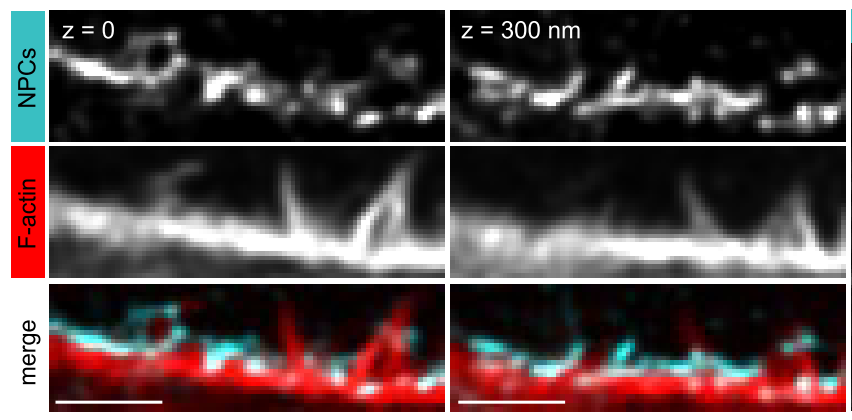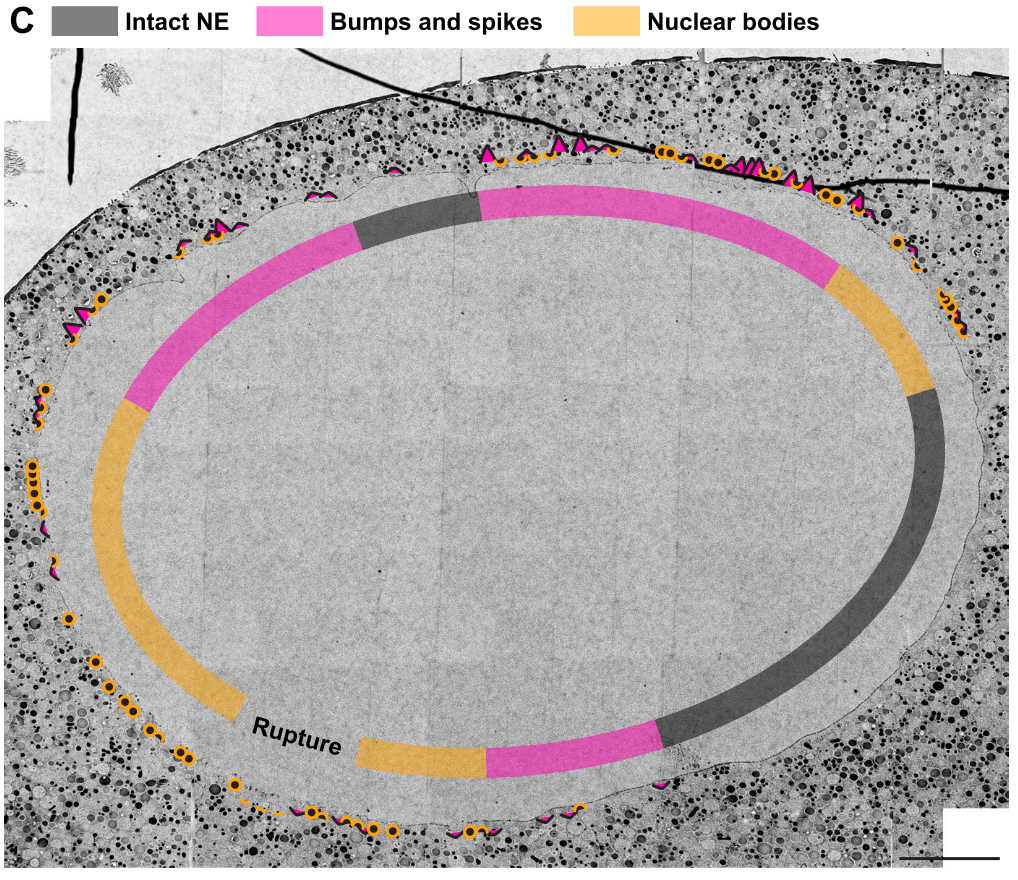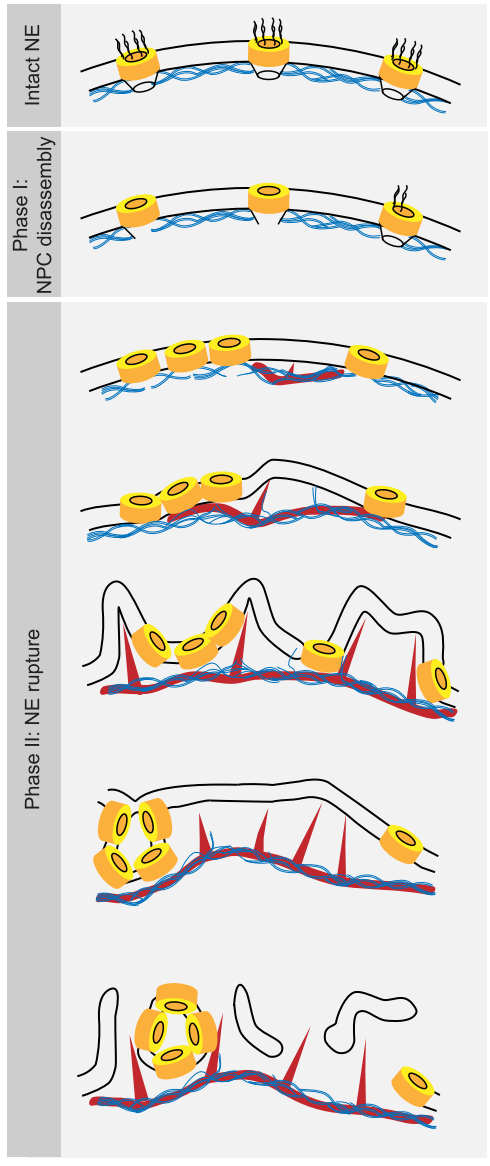An F-actin shell ruptures the nuclear envelope by sorting pore-dense and pore-free membranes in meiosis of starfish oocytes
Posted on: 19 December 2018
Preprint posted on 28 November 2018
Watch out! F-actin spikes push against the nuclear envelope to separate nuclear pores and lead to nuclear envelope breakdown
Selected by Maiko KitaokaCategories: cell biology
Background
The nuclear envelope is a specialized structure composed of membrane proteins that protects the nuclear content from the cytoplasm. In interphase, this compartmentalization of nuclear vs. cytoplasmic content allows the cell to regulate gene expression and transport. However, the nuclear envelope must break down during every cell division in order for the microtubule cytoskeleton to contact the chromosomes and allow for faithful segregation. This occurs in two phases: First, the nuclear envelope is gradually permeabilized as nuclear pore complexes and other proteins are disassembled by phosphorylation signals, thus weakening the nuclear envelope and slowly allowing proteins to leak in and out. Second, the nuclear envelope suddenly ruptures so that the cytoplasm mixes quickly and completely with the nuclear contents. This phase is visible with light microscopy and is referred to as nuclear envelope breakdown (NEBD). Following rapid mitotic spindle formation and chromosome segregation, the nuclear envelope must then be quickly reassembled to ensure the integrity of the genome following cell division.
The Lenart lab has previously demonstrated the importance of the actin cytoskeleton in rupturing the nuclear envelope due to the presence of a transient F-actin shell on the nuclear envelope. Now, Wesolowska et al use starfish oocytes to continue the investigation into the role of this F-actin shell in mediating nuclear membrane rupture. Here, they use confocal and super-resolution microscopy as well as correlated electron microscopy to observe the rapid and dramatic changes in nuclear envelope morphology to find that the F-actin shell on the inner surface of the nuclear envelope projects spikes into the nuclear membranes. They propose that this can generate force and pull apart the nuclear membranes to destabilize the structure during NEBD.
Key findings
By carefully analyzing samples at different stages of nuclear envelope morphological changes, the authors confirmed previous observations that the lamina network remains intact after nuclear envelope rupture, though it folds during NEBD. The nuclear envelope forms a separate layer from the F-actin shell, while the lamina network co-localized with actin by phalloidin staining. This indicates that the lamina serves as the scaffold for F-actin to assemble, but the nuclear membranes are detached from the lamina by the F-actin shell.
Upon closer investigation, the group found that the F-actin shell forms spikes that go through the nuclear membrane. Super-resolution STED microscopy revealed that these F-actin spikes are 0.5-2 µm in length and 0.1 µm apart from each other. After NEBD, the nuclear envelope appeared to be “floating” above the laminar network, a detachment that is dependent on the F-actin shell.

Due to technical limitations of preserving both filamentous actin and fine membrane structures, the authors turned to correlative light and electron microscopy to examine these spikes at the membrane in further detail. Strikingly, the EM images showed that the F-actin spikes were localized to regions of nuclear membrane that had no nuclear pore complexes. Pore-free areas were in turn adjacent to pore-dense regions. This suggested that growing gaps between pore complexes are extruded by the F-actin spikes, sorting the nuclear envelope globally to pore-free and pore-dense regions even when the membrane is initially intact.

In addition to the F-actin spikes, the authors also observed nucleoplasmic bodies that formed beneath the nuclear envelope. These bodies seemed reminiscent of several potential processes, including aggregation of nuclear pore complexes into the nucleoplasm and membrane vesicle formation. The authors suggest that these bodies may be inverted nuclear envelope tubules filled with cytoplasm, which is also indicated by the presence of ribosomes. However, their exact composition and purpose still remain unclear.
To conclude, Wesolowska et al used advanced light and electron microscopy to determine that F-actin spikes push against the nuclear membrane. This separates the pore-free regions from the nuclear lamina, while the pores accumulate between F-actin spikes. Together, this causes the membrane to buckle and invaginate as it weakens, eventually rupturing and causing complete nuclear envelope breakdown.

Questions for the authors
How do the F-actin spikes “know” where to push on the nuclear membrane? They need to polymerize actin in pore-free regions, so how is that detected? Or do the spikes polymerize randomly until they find an area without nuclear pores?
What mechanism(s) connect the phosphorylation-based disassembly of nuclear pore complexes and the actin polymerization necessary to create these F-actin spikes that eventually causes nuclear envelope rupture?
If the nucleoplasmic bodies are inverted nuclear envelope tubules as suggested, how do they help to mediate NEBD, and what happens to them after NEBD?
doi: https://doi.org/10.1242/prelights.6208
Read preprintSign up to customise the site to your preferences and to receive alerts
Register hereAlso in the cell biology category:
Cell cycle-dependent mRNA localization in P-bodies
Mohammed JALLOH
Control of Inflammatory Response by Tissue Microenvironment
Roberto Amadio
Notch3 is a genetic modifier of NODAL signalling for patterning asymmetry during mouse heart looping
Bhaval Parmar
preLists in the cell biology category:
BSCB-Biochemical Society 2024 Cell Migration meeting
This preList features preprints that were discussed and presented during the BSCB-Biochemical Society 2024 Cell Migration meeting in Birmingham, UK in April 2024. Kindly put together by Sara Morais da Silva, Reviews Editor at Journal of Cell Science.
| List by | Reinier Prosee |
‘In preprints’ from Development 2022-2023
A list of the preprints featured in Development's 'In preprints' articles between 2022-2023
| List by | Alex Eve, Katherine Brown |
preLights peer support – preprints of interest
This is a preprint repository to organise the preprints and preLights covered through the 'preLights peer support' initiative.
| List by | preLights peer support |
The Society for Developmental Biology 82nd Annual Meeting
This preList is made up of the preprints discussed during the Society for Developmental Biology 82nd Annual Meeting that took place in Chicago in July 2023.
| List by | Joyce Yu, Katherine Brown |
CSHL 87th Symposium: Stem Cells
Preprints mentioned by speakers at the #CSHLsymp23
| List by | Alex Eve |
Journal of Cell Science meeting ‘Imaging Cell Dynamics’
This preList highlights the preprints discussed at the JCS meeting 'Imaging Cell Dynamics'. The meeting was held from 14 - 17 May 2023 in Lisbon, Portugal and was organised by Erika Holzbaur, Jennifer Lippincott-Schwartz, Rob Parton and Michael Way.
| List by | Helen Zenner |
9th International Symposium on the Biology of Vertebrate Sex Determination
This preList contains preprints discussed during the 9th International Symposium on the Biology of Vertebrate Sex Determination. This conference was held in Kona, Hawaii from April 17th to 21st 2023.
| List by | Martin Estermann |
Alumni picks – preLights 5th Birthday
This preList contains preprints that were picked and highlighted by preLights Alumni - an initiative that was set up to mark preLights 5th birthday. More entries will follow throughout February and March 2023.
| List by | Sergio Menchero et al. |
CellBio 2022 – An ASCB/EMBO Meeting
This preLists features preprints that were discussed and presented during the CellBio 2022 meeting in Washington, DC in December 2022.
| List by | Nadja Hümpfer et al. |
Fibroblasts
The advances in fibroblast biology preList explores the recent discoveries and preprints of the fibroblast world. Get ready to immerse yourself with this list created for fibroblasts aficionados and lovers, and beyond. Here, my goal is to include preprints of fibroblast biology, heterogeneity, fate, extracellular matrix, behavior, topography, single-cell atlases, spatial transcriptomics, and their matrix!
| List by | Osvaldo Contreras |
EMBL Synthetic Morphogenesis: From Gene Circuits to Tissue Architecture (2021)
A list of preprints mentioned at the #EESmorphoG virtual meeting in 2021.
| List by | Alex Eve |
FENS 2020
A collection of preprints presented during the virtual meeting of the Federation of European Neuroscience Societies (FENS) in 2020
| List by | Ana Dorrego-Rivas |
Planar Cell Polarity – PCP
This preList contains preprints about the latest findings on Planar Cell Polarity (PCP) in various model organisms at the molecular, cellular and tissue levels.
| List by | Ana Dorrego-Rivas |
BioMalPar XVI: Biology and Pathology of the Malaria Parasite
[under construction] Preprints presented at the (fully virtual) EMBL BioMalPar XVI, 17-18 May 2020 #emblmalaria
| List by | Dey Lab, Samantha Seah |
1
Cell Polarity
Recent research from the field of cell polarity is summarized in this list of preprints. It comprises of studies focusing on various forms of cell polarity ranging from epithelial polarity, planar cell polarity to front-to-rear polarity.
| List by | Yamini Ravichandran |
TAGC 2020
Preprints recently presented at the virtual Allied Genetics Conference, April 22-26, 2020. #TAGC20
| List by | Maiko Kitaoka et al. |
3D Gastruloids
A curated list of preprints related to Gastruloids (in vitro models of early development obtained by 3D aggregation of embryonic cells). Updated until July 2021.
| List by | Paul Gerald L. Sanchez and Stefano Vianello |
ECFG15 – Fungal biology
Preprints presented at 15th European Conference on Fungal Genetics 17-20 February 2020 Rome
| List by | Hiral Shah |
ASCB EMBO Annual Meeting 2019
A collection of preprints presented at the 2019 ASCB EMBO Meeting in Washington, DC (December 7-11)
| List by | Madhuja Samaddar et al. |
EMBL Seeing is Believing – Imaging the Molecular Processes of Life
Preprints discussed at the 2019 edition of Seeing is Believing, at EMBL Heidelberg from the 9th-12th October 2019
| List by | Dey Lab |
Autophagy
Preprints on autophagy and lysosomal degradation and its role in neurodegeneration and disease. Includes molecular mechanisms, upstream signalling and regulation as well as studies on pharmaceutical interventions to upregulate the process.
| List by | Sandra Malmgren Hill |
Lung Disease and Regeneration
This preprint list compiles highlights from the field of lung biology.
| List by | Rob Hynds |
Cellular metabolism
A curated list of preprints related to cellular metabolism at Biorxiv by Pablo Ranea Robles from the Prelights community. Special interest on lipid metabolism, peroxisomes and mitochondria.
| List by | Pablo Ranea Robles |
BSCB/BSDB Annual Meeting 2019
Preprints presented at the BSCB/BSDB Annual Meeting 2019
| List by | Dey Lab |
MitoList
This list of preprints is focused on work expanding our knowledge on mitochondria in any organism, tissue or cell type, from the normal biology to the pathology.
| List by | Sandra Franco Iborra |
Biophysical Society Annual Meeting 2019
Few of the preprints that were discussed in the recent BPS annual meeting at Baltimore, USA
| List by | Joseph Jose Thottacherry |
ASCB/EMBO Annual Meeting 2018
This list relates to preprints that were discussed at the recent ASCB conference.
| List by | Dey Lab, Amanda Haage |











 (No Ratings Yet)
(No Ratings Yet)